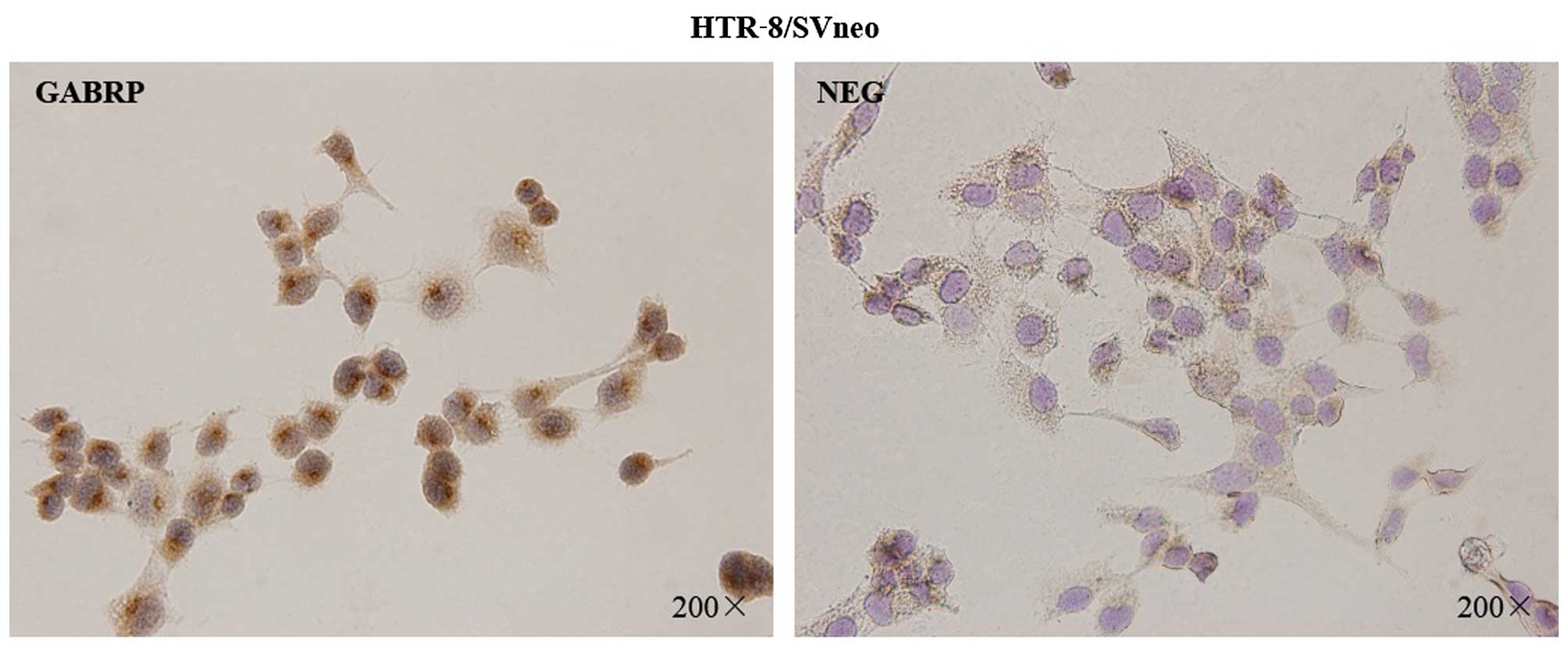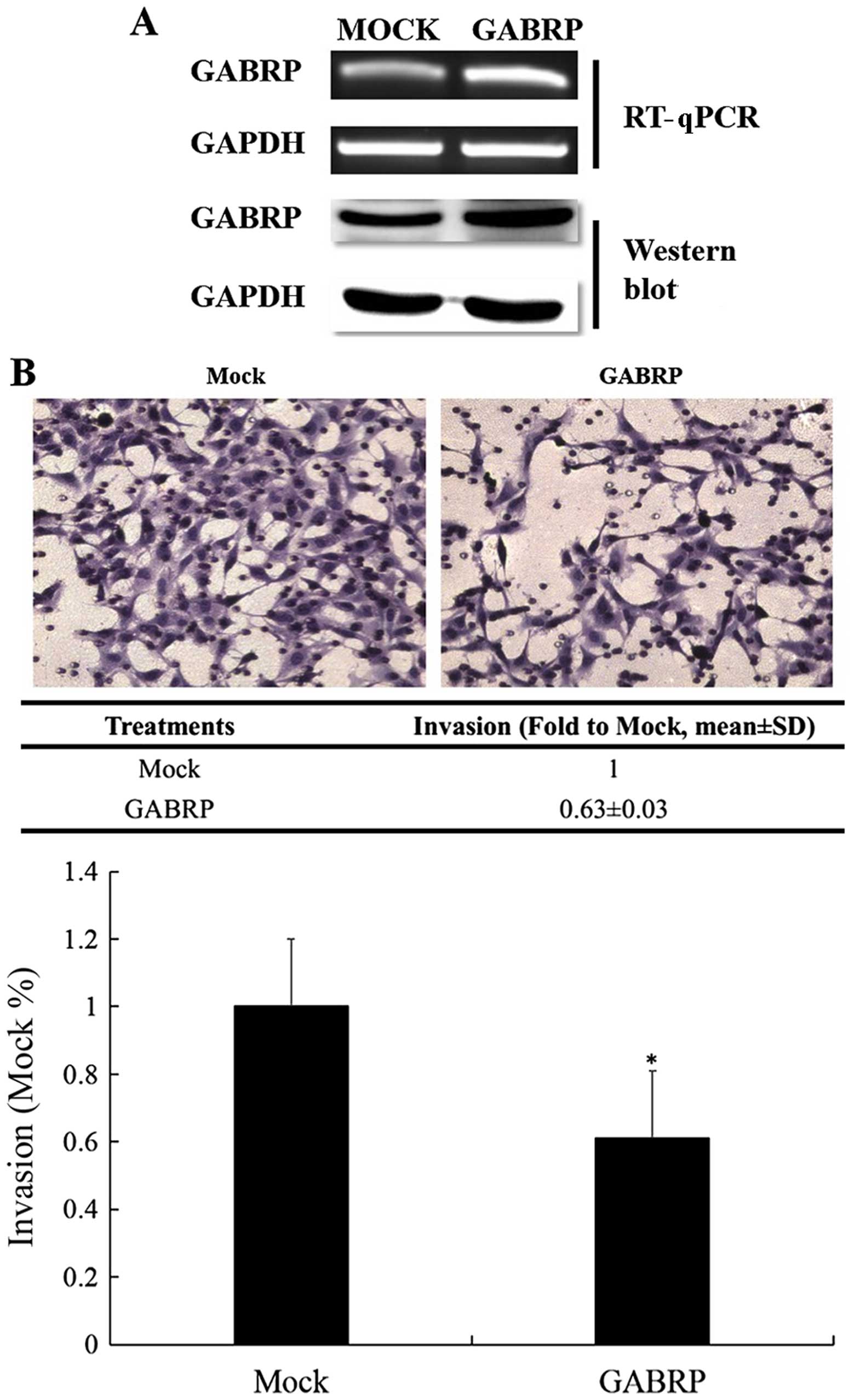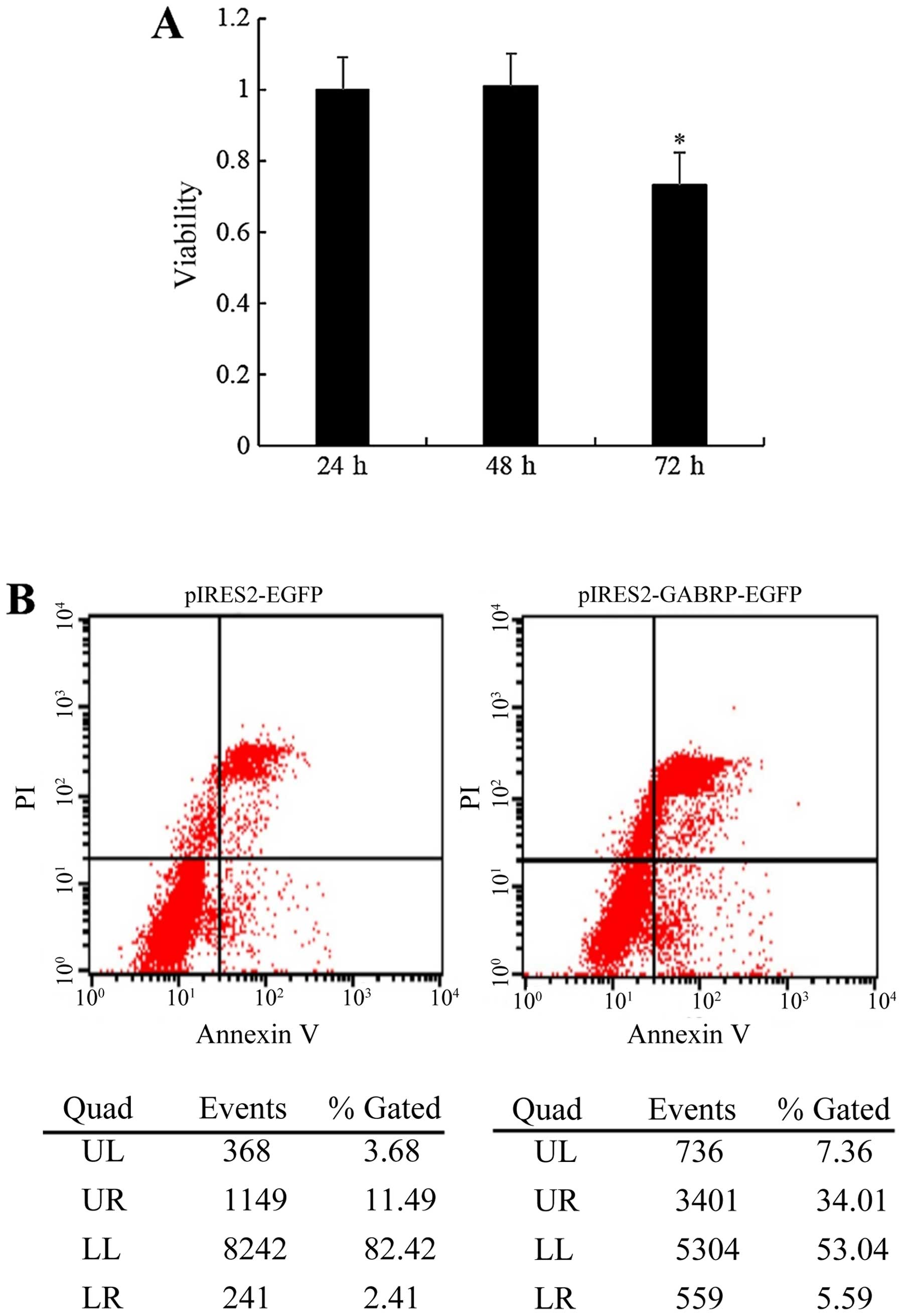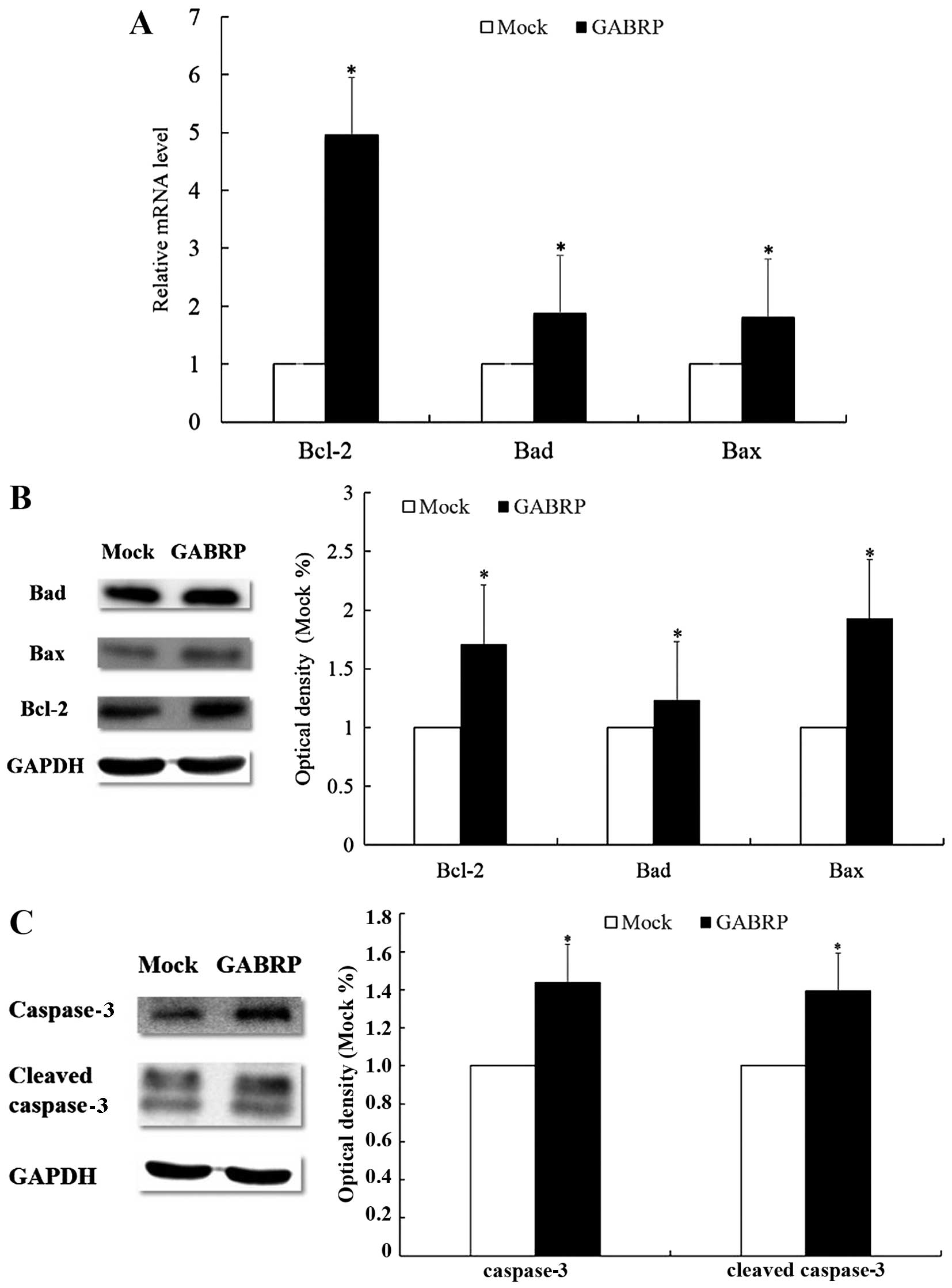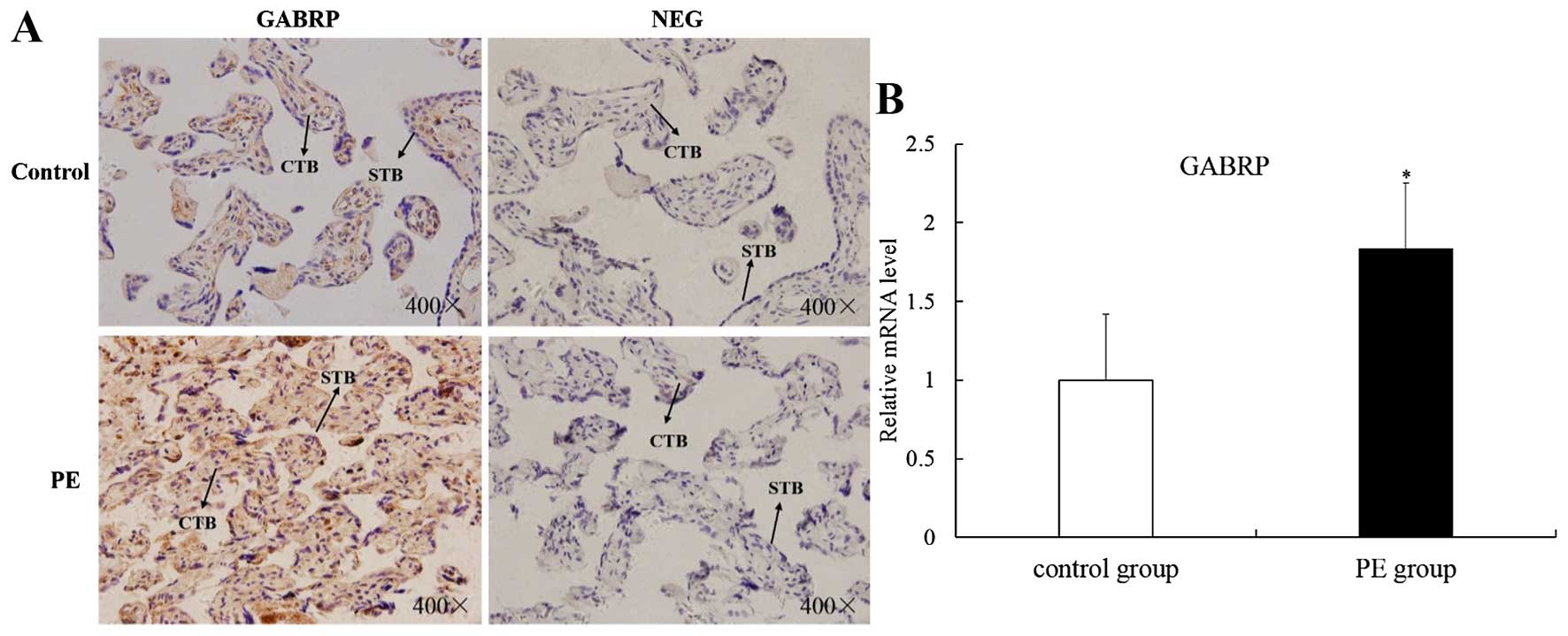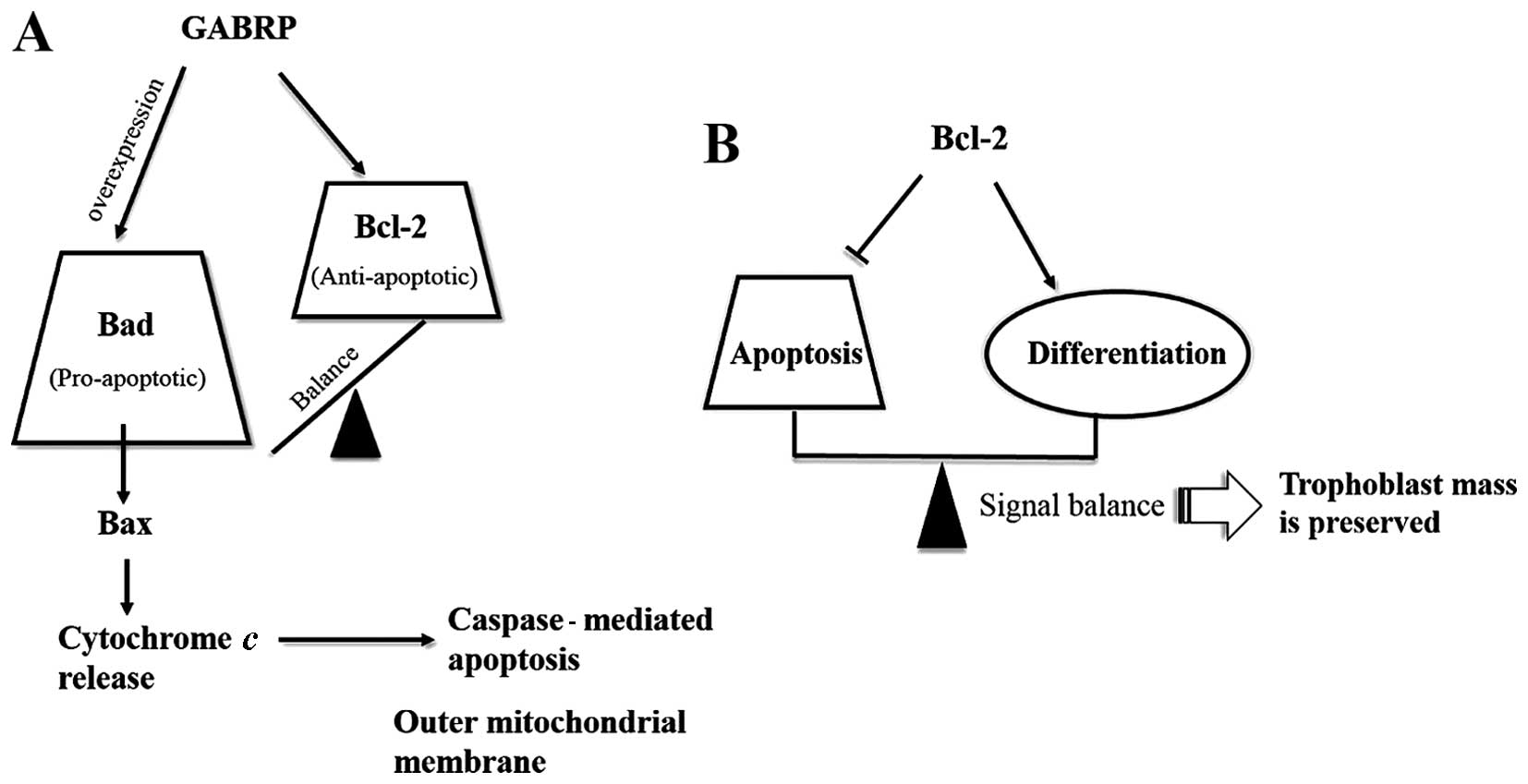|
1
|
Hedblom E and Kirkness EF: A novel class
of GABAA receptor subunit in tissues of the reproductive system. J
Biol Chem. 272:15346–15350. 1997. View Article : Google Scholar : PubMed/NCBI
|
|
2
|
Zafrakas M, Chorovicer M, Klaman I,
Kristiansen G, Wild PJ, Heindrichs U, Knüchel R and Dahl E:
Systematic characterisation of GABRP expression in sporadic breast
cancer and normal breast tissue. Int J Cancer. 118:1453–1459. 2006.
View Article : Google Scholar
|
|
3
|
Gladkevich A, Korf J, Hakobyan VP and
Melkonyan KV: The peripheral GABAergic system as a target in
endocrine disorders. 124:1–8. 2006.
|
|
4
|
Fujii E and Mellon SH: Regulation of
uterine gamma-aminobutyric acid(A) receptor subunit expression
throughout pregnancy. Endocrinology. 142:1770–1777. 2001.PubMed/NCBI
|
|
5
|
Sadeghi H and Taylor HS: HOXA10 regulates
endometrial GABAA (pi) receptor expression and membrane
translocation. Am J Physiol Endocrinol Metab. 298:E889–E893. 2010.
View Article : Google Scholar : PubMed/NCBI
|
|
6
|
Longtine MS, Chen B, Odibo AO, Zhong Y and
Nelson DM: Villous trophoblast apoptosis is elevated and restricted
to cytotrophoblasts in pregnancies complicated by preeclampsia,
IUGR, or preeclampsia with IUGR. Placenta. 33:352–359. 2012.
View Article : Google Scholar : PubMed/NCBI
|
|
7
|
Luo W, Liu Z, Tan D, Zhang Q, Peng H, Wang
Y and Tan Y: Gamma-amino butyric acid and the A-type receptor
suppress decidualization of mouse uterine stromal cells by
down-regulating cyclin D3. Mol Reprod Dev. 80:59–69. 2013.
View Article : Google Scholar
|
|
8
|
Allaire AD, Ballenger KA, Wells SR,
McMahon MJ and Lessey BA: Placental apoptosis in preeclampsia.
Obstet Gynecol. 96:271–276. 2000.PubMed/NCBI
|
|
9
|
Zhang Q, Chen Q, Lu X, Zhou Z, Zhang H,
Lin HY, Duan E, Zhu C, Tan Y and Wang H: CUL1 promotes trophoblast
cell invasion at the maternal-fetal interface. Cell Death Dis.
4:e5022013. View Article : Google Scholar : PubMed/NCBI
|
|
10
|
Sharp AN, Heazell AE, Crocker IP and Mor
G: Placental apoptosis in health and disease. Am J Reprod Immunol.
64:159–169. 2010. View Article : Google Scholar : PubMed/NCBI
|
|
11
|
Straszewski-Chavez SL, Abrahams VM and Mor
G: The role of apoptosis in the regulation of trophoblast survival
and differentiation during pregnancy. Endocr Rev. 26:877–897. 2005.
View Article : Google Scholar : PubMed/NCBI
|
|
12
|
Crocker IP, Cooper S, Ong SC and Baker PN:
Differences in apoptotic susceptibility of cytotrophoblasts and
syncytiotrophoblasts in normal pregnancy to those complicated with
preeclampsia and intrauterine growth restriction. Am J Pathol.
162:637–643. 2003. View Article : Google Scholar : PubMed/NCBI
|
|
13
|
Marzioni D, Mühlhauser J, Crescimanno C,
Banita M, Pierleoni C and Castellucci M: BCL-2 expression in the
human placenta and its correlation with fibrin deposits. Hum
Reprod. 13:1717–1722. 1998. View Article : Google Scholar : PubMed/NCBI
|
|
14
|
Krajewski S, Krajewska M and Reed JC:
Immunohistochemical analysis of in vivo patterns of Bak expression,
a proapoptotic member of the Bcl-2 protein family. Cancer Res.
56:2849–2855. 1996.PubMed/NCBI
|
|
15
|
Cory S, Huang DC and Adams JM: The Bcl-2
family: roles in cell survival and oncogenesis. Oncogene.
22:8590–8607. 2003. View Article : Google Scholar : PubMed/NCBI
|
|
16
|
Huppertz B and Kingdom JC: Apoptosis in
the trophoblast - role of apoptosis in placental morphogenesis. J
Soc Gynecol Investig. 11:353–362. 2004. View Article : Google Scholar : PubMed/NCBI
|
|
17
|
Huppertz B, Kadyrov M and Kingdom JC:
Apoptosis and its role in the trophoblast. Am J Obstet Gynecol.
195:29–39. 2006. View Article : Google Scholar : PubMed/NCBI
|
|
18
|
Ratts VS, Tao XJ, Webster CB, Swanson PE,
Smith SD, Brownbill P, Krajewski S, Reed JC, Tilly JL and Nelson
DM: Expression of BCL-2, BAX and BAK in the trophoblast layer of
the term human placenta: a unique model of apoptosis within a
syncytium. Placenta. 21:361–366. 2000. View Article : Google Scholar : PubMed/NCBI
|
|
19
|
Murakoshi H, Matsuo H, Laoag-Fernandez JB,
Samoto T and Maruo T: Expression of Fas/Fas-ligand, Bcl-2 protein
and apoptosis in extravillous trophoblast along invasion to the
decidua in human term placenta. Endocr J. 50:199–207. 2003.
View Article : Google Scholar : PubMed/NCBI
|
|
20
|
Ho S, Winkler-Lowen B, Morrish DW, Dakour
J, Li H and Guilbert LJ: The role of Bcl-2 expression in EGF
inhibition of TNF-alpha/IFN-gamma-induced villous trophoblast
apoptosis. Placenta. 20:423–430. 1999. View Article : Google Scholar : PubMed/NCBI
|
|
21
|
Candelier JJ, Frappart L, Yadaden T, Poaty
H, Picard JY, Prévot S and Coullin P: Altered p16 and Bcl-2
expression reflects pathologic development in hydatidiform moles
and choriocarcinoma. Pathol Oncol Res. 19:217–227. 2013. View Article : Google Scholar
|
|
22
|
Lea RG, al-Sharekh N, Tulppala M and
Critchley HO: The immunolocalization of bcl-2 at the maternal-fetal
interface in healthy and failing pregnancies. Hum Reprod.
12:153–158. 1997. View Article : Google Scholar : PubMed/NCBI
|
|
23
|
Sakuragi N, Matsuo H, Coukos G, Furth EE,
Bronner MP, VanArsdale CM, Krajewsky S, Reed JC and Strauss JF III:
Differentiation-dependent expression of the BCL-2 proto-oncogene in
the human trophoblast lineage. J Soc Gynecol Investig. 1:164–172.
1994.PubMed/NCBI
|
|
24
|
Huppertz B, Tews DS and Kaufmann P:
Apoptosis and syncytial fusion in human placental trophoblast and
skeletal muscle. Int Rev Cytol. 205:215–253. 2001. View Article : Google Scholar : PubMed/NCBI
|
|
25
|
Black S, Kadyrov M, Kaufmann P, Ugele B,
Emans N and Huppertz B: Syncytial fusion of human trophoblast
depends on caspase 8. Cell Death Differ. 11:90–98. 2004. View Article : Google Scholar
|
|
26
|
Gauster M, Siwetz M, Orendi K, Moser G,
Desoye G and Huppertz B: Caspases rather than calpains mediate
remodelling of the fodrin skeleton during human placental
trophoblast fusion. Cell Death Differ. 17:336–345. 2010. View Article : Google Scholar
|
|
27
|
Sizemore GM, Sizemore ST, Seachrist DD and
Keri RA: GABA(A) receptor pi (GABRP) stimulates basal-like breast
cancer cell migration through activation of extracellular-regulated
kinase 1/2 (ERK1/2). J Biol Chem. 289:24102–24113. 2014. View Article : Google Scholar : PubMed/NCBI
|
|
28
|
Johnson SK and Haun RS: The
gamma-aminobutyric acid A receptor pi subunit is overexpressed in
pancreatic adenocarcinomas. JOP. 6:136–142. 2005.PubMed/NCBI
|
|
29
|
Takehara A, Hosokawa M, Eguchi H, Ohigashi
H, Ishikawa O, Nakamura Y and Nakagawa H: Gamma-aminobutyric acid
(GABA) stimulates pancreatic cancer growth through overexpressing
GABAA receptor pi subunit. Cancer Res. 67:9704–9712. 2007.
View Article : Google Scholar : PubMed/NCBI
|
|
30
|
Young SZ and Bordey A: GABA's control of
stem and cancer cell proliferation in adult neural and peripheral
niches. Physiology (Bethesda). 24:171–185. 2009. View Article : Google Scholar
|
|
31
|
Watanabe M, Maemura K, Oki K, Shiraishi N,
Shibayama Y and Katsu K: Gamma-aminobutyric acid (GABA) and cell
proliferation: focus on cancer cells. Histol Histopathol.
21:1135–1141. 2006.PubMed/NCBI
|
|
32
|
Ortega A: A new role for GABA: inhibition
of tumor cell migration. Trends Pharmacol Sci. 24:151–154. 2003.
View Article : Google Scholar : PubMed/NCBI
|
|
33
|
Perry JK, Lins RJ, Lobie PE and Mitchell
MD: Regulation of invasive growth: similar epigenetic mechanisms
underpin tumour progression and implantation in human pregnancy.
Clin Sci (Lond). 118:451–457. 2009. View Article : Google Scholar
|
|
34
|
Murray MJ and Lessey BA: Embryo
implantation and tumor metastasis: common pathways of invasion and
angiogenesis. Semin Reprod Endocrinol. 17:275–290. 1999. View Article : Google Scholar
|
|
35
|
Ferretti C, Bruni L, Dangles-Marie V,
Pecking AP and Bellet D: Molecular circuits shared by placental and
cancer cells, and their implications in the proliferative, invasive
and migratory capacities of trophoblasts. Hum Reprod Update.
13:121–141. 2007. View Article : Google Scholar
|



